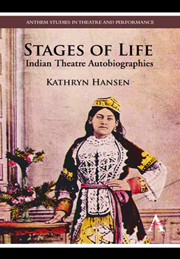Book contents
- Frontmatter
- Contents
- Illustrations
- Preface
- Acknowledgments
- PART 1
- 1 Pioneers to Professionals: A Retrospective of the Parsi Theatre
- 2 Theatrical Memoirs and the Archives of Autobiography
- PART 2
- PART 3
- Appendix 1 Historical Personages and Institutions
- Appendix 2 List of Plays and Films
- Glossary: Hindi and Urdu Terms
- Bibliography
- Index
1 - Pioneers to Professionals: A Retrospective of the Parsi Theatre
from PART 1
Published online by Cambridge University Press: 05 March 2012
- Frontmatter
- Contents
- Illustrations
- Preface
- Acknowledgments
- PART 1
- 1 Pioneers to Professionals: A Retrospective of the Parsi Theatre
- 2 Theatrical Memoirs and the Archives of Autobiography
- PART 2
- PART 3
- Appendix 1 Historical Personages and Institutions
- Appendix 2 List of Plays and Films
- Glossary: Hindi and Urdu Terms
- Bibliography
- Index
Summary
In South Asia, new forms of theatre stemming from the European encounter developed around 1850. The Parsis of Bombay, Zoroastrians who had come from Iran a millennium earlier, were one of the first groups to adopt Western modes of stagecraft and organize dramatic companies. They were not alone: the Gujarati, Marathi, Bengali, and other Indian-language theatres offered spectators comparable diversions by the early twentieth century. Regardless of ethnic or regional affiliation, all participated in a commercial entertainment economy and played to a bourgeois class of spectators in cities with rapid economic growth. Everywhere, forms of music, dance, and drama once restricted to aristocratic groups became ready commodities. The theatre experience became a defining feature of colonial modernity across South Asia.
Within this overall transformation, the Parsi theatre occupied a distinct space. It was identified by its entrepreneurial backbone, not by its performers, audience, language, or content. The Parsi theatre companies contained a mix of Parsis and non-Parsis, as did their audiences, and the dramatic fare they offered rarely referred to Parsi religion or culture. In fact, Parsi theatre, both by the composition of its personnel and the sorts of plays it staged, synthesized elements of Asian and European origin, lending it a hybrid, middle-brow character. Most unusually, its large companies circulated throughout the subcontinent. Touring by rail and ship, they reached a vast territory and achieved a remarkable degree of popularity.
- Type
- Chapter
- Information
- Stages of LifeIndian Theatre Autobiographies, pp. 3 - 25Publisher: Anthem PressPrint publication year: 2011



